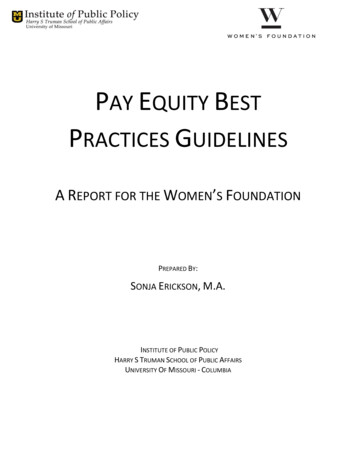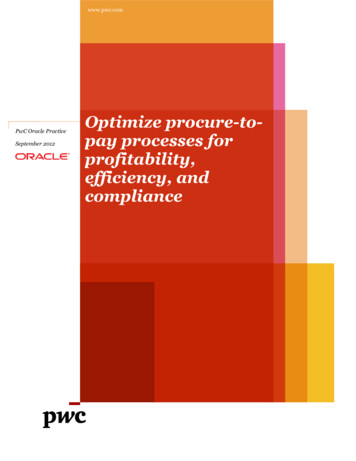
Transcription
CONGRESS OF THE UNITED STATESCONGRESSIONAL BUDGET OFFICEACBOPAPERAUGUST 2005 StockDiscComparingthe Pay ofFederal andNonfederalLaw EnforcementOfficers
ACBOPA P ERComparing the Pay ofFederal and NonfederalLaw Enforcement OfficersAugust 2005The Congress of the United States O Congressional Budget Office
NoteNumbers in the text and tables may not add up to totals because of rounding.
PrefaceAs lawmakers consider changes in the federal personnel system for law enforcementofficers, one issue to be considered is whether the compensation of such personnel across thegovernment is adequate to achieve recruitment and retention goals. Some observers argue thatin a number of cities, compensation for federal law enforcement officers is less than that fortheir state and local counterparts, which may place the federal government at a relative disadvantage in some local labor markets.This Congressional Budget Office (CBO) paper compares the pay (wages and salaries) of federal law enforcement officers with the pay of nonfederal officers in the national and regionallabor markets and in selected federal locality-pay areas. (CBO’s analysis excludes comparisonsof employment benefits.) The paper was prepared at the request of the Subcommittee onOversight of Government Management, the Federal Workforce, and the District of Columbiaof the Senate Homeland Security and Governmental Affairs Committee and the Subcommittee on the Federal Workforce and Agency Organization of the House Committee on Government Reform. In accordance with CBO’s mandate to provide impartial analysis, this papermakes no recommendations.Cary Elliott of CBO’s Microeconomic Studies Division wrote the paper under the supervisionof Roger Hitchner, Joseph Kile, and David Moore. (Roger Hitchner has since left CBO.) Theauthor received valuable comments and assistance from Molly Dahl, Ellen Hays, ArleneHolen, William Randolph, Ralph Smith, and Sean Sullivan of CBO, as well as BarbaraSchwemle of the Congressional Research Service, Kevin Hallock of Cornell University, andMark Musell, formerly of CBO. (The assistance of external reviewers implies no responsibilityfor the final product, which rests solely with CBO.)Leah Mazade edited the paper, and John Skeen proofread it. Angela Z. McCollough preparedearly drafts of the manuscript; Maureen Costantino designed the cover and prepared thereport for publication. Lenny Skutnik produced the printed copies, and Annette Kalicki andSimone Thomas prepared the electronic version for CBO’s Web site (www.cbo.gov).Douglas Holtz-EakinDirectorAugust 2005
CONTENTSSummary viiOverview of Federal and Nonfederal Law EnforcementSystems 1Comparing Federal and Nonfederal LawEnforcement Jobs and Requirements 1Comparing Federal and Nonfederal Pay Structures 4Pay Comparisons Using the Human Capital Approach 7CBO’s Analysis 9Data 9Comparing Unadjusted Earnings 9Comparing Individuals’ Personal and JobCharacteristics 10Comparing Adjusted Differentials 12Results for Selected Localities 14Explaining Differences That Remain After CBO’sAdjustments 14Appendix: CBO’s Analytic Method 17
viCOMPARING THE PAY OF FEDERAL AND NONFEDERAL LAW ENFORCEMENT OFFICERSTablesS-1.1.2.3.4.5.6.7.A-1.Estimated Federal Earnings Differentials as Nationwide AveragesAfter Adjusting for Officers’ Personal and Job CharacteristicsxMajor Employing Agencies of Federal Law Enforcement Officers,June 20024Number of Federal Law Enforcement Officers in SelectedOccupations by State, March 20045Number of Law Enforcement Officers in CBO’s Sample byOccupation and Employer9Estimated Federal Earnings Differentials by Region WithoutAdjusting for Law Enforcement Officers’ Personal and JobCharacteristics10Personal and Job Characteristics and Average Earnings ofLaw Enforcement Officers11Estimated Federal Earnings Differentials by Region AfterAdjusting for Law Enforcement Officers’ Personal and JobCharacteristics13Estimated Federal Earnings Differentials in Selected LargeLocalities After Adjusting for Officers’ Personal and JobCharacteristics15Annual Log Wage Earnings Regressions for Selected LawEnforcement Job Categories18FiguresS-1.S-2.1.Estimated Federal Earnings Differentials for Police Officers inSelected LocalitiesxiEstimated Federal Earnings Differentials for Detectives andCriminal Investigators in Selected LocalitiesxiiDuties of Federal Law Enforcement Officers3BoxS-1Analyzing Total Compensation for Law Enforcement Jobsviii
SummaryThe Office of Personnel Management (OPM) estimated in 2004 that roughly 106,000 law enforcement officers were employed in various federal agencies, such asthe Department of Homeland Security (DHS), the Federal Bureau of Investigation, and the Federal Bureau ofPrisons.1 The September 2001 terrorist attacks haveheightened policymakers’ concerns about the federal government’s ability to recruit and retain high-quality personnel for those positions. Central to those concerns isthe level of federal pay for law enforcement jobs in comparison with that offered by state and local governments,particularly in metropolitan areas where the cost of livingis high. This Congressional Budget Office (CBO) analysis compares the pay (wages and salaries) of federal lawenforcement officers with the pay of similar nonfederalofficers (those employed by state and local—includingcounty —governments).2 CBO’s study was restricted tocash compensation, for which comprehensive data areavailable. It did not address total compensation—earnings plus benefits. (See Box 1 for a brief discussion of total compensation.)The federal government competes in various labor markets with state and local governments—and to a lesser extent, those public-sector employers compete with privateproviders of protective services—for people with law enforcement skills. To compare the pay of federal officerswith that of state and local officers, CBO used data fromthe 2000 decennial census. Its analysis focused on five of1. Office of Personnel Management, Federal Law Enforcement Payand Benefits: Report to the Congress (July 2004). That report compared job classifications, pay, and benefits among federal lawenforcement officers.2. CBO’s previous pay comparison analyses include Comparing Federal Salaries with Those in the Private Sector (July 1997), whichused a human capital approach similar to the one employed in thisanalysis; Comparing Federal Employee Benefits with Those in thePrivate Sector (August 1998); and, most recently, Comparing thePay of Federal and Nonprofit Executives: An Update (July 2003) andMeasuring Differences Between Federal and Private Pay (November2002).the census’s classifications of law enforcement jobs: policeofficers; detectives and criminal investigators; correctionsofficers (including bailiffs and jailers); police supervisors;and corrections supervisors.3A number of factors may account for observed differencesin pay in addition to the pay structure of an officer’s employer. Those factors include nonwage employment benefits—for example, contributions by employers for retirement and health insurance; differences in the skills andabilities of the people in law enforcement jobs, importantaspects of which are education and previous experience; aparticular job’s requirements; and individuals’ preferences—for instance, whether people are willing to move often,as some federal jobs demand, and how much risk they arewilling to tolerate.CBO used statistical techniques—based on a human capital approach to pay determination—to account for officers’ personal and job characteristics that affect their pay.After taking those characteristics into account, CBOfound that federal pay tended to be higher than state andlocal pay when compared on the basis of national averages. Federal police officers, investigators, and correctionsofficers on average earned more than their state and localcounterparts. However, those average results do not takeinto account possible differences between federal andnonfederal employment benefits. Moreover, the nationalaverages mask important differences among regions andlocalities. As an example, for police officers in several major metropolitan areas (such as New York and Los Angeles), federal salaries are below the salaries paid by stateand local law enforcement agencies.3. Private-sector law enforcement officers, such as private securityofficers and private detectives, were excluded from CBO’s analysissince they lack the arrest powers that distinguish federal and stateand local officers. However, private employment remains anoption for both law enforcement recruits and veteran officers.
viiiSUMMARYSummary Box 1.Analyzing Total Compensation for Law Enforcement JobsThe Congressional Budget Office’s (CBO’s) paycomparison of federal and state and local law enforcement officers focused on cash compensation.Total compensation includes not only earnings fromsalaries and wages but also the value of employmentbenefits, such as retirement, health care, and life insurance benefits; holiday and vacation pay; and subsidies for transportation, housing, and uniforms.Benefits are a significant part of employees’ remuneration. A 1998 analysis by CBO found that, depending on employees’ age, salary, length of service, andretirement plan, benefits for federal employees accounted for 26 percent to 50 percent of their totalcompensation.1 For employees of large private firms,benefits made up 24 percent to 44 percent of compensation. (Law enforcement retirement falls underthe governmentwide Federal Employees RetirementSystem, or FERS—and for certain older officers, under the Civil Service Retirement System—but it hasadditional enhancements.)In 1990, the National Advisory Commission on LawEnforcement (NACLE) compared the employmentbenefits provided to state and local law enforcementofficers with those received by federal law enforcement officers.2 The commission determined that,relative to state and local governments, “[t]he federalgovernment more often provides fewer benefits inthe areas of life insurance, paid holidays, cash allowances, employee cost and some aspects of coverage ofhealth insurance, and disability benefits.” The commission also concluded that federal law enforcementretirement benefits generally “compare favorably tothose provided by state and local employers, but thecost to the federal employee is higher than that of thestate and local employee.”3 NACLE’s report wasbased on the results of a nationwide survey of law enforcement agencies and officers. No comparable dataon benefits have been collected since that 1990survey.Information is available concerning federal as well asstate and local retirement plans for law enforcementofficers.4 However, the complexity of those plans’provisions makes comparison difficult and subject toa large number of assumptions. Such an analysis isbeyond the scope of this report. Nevertheless, thedata generally indicate a high degree of variabilityamong state retirement plans.2. National Advisory Commission on Law Enforcement,Report of the National Advisory Commission on Law Enforcement, OCG-90-2 (Comptroller General of the UnitedStates, April 1990), p. 72.3. Ibid.1. See Congressional Budget Office, Comparing FederalEmployee Benefits with Those in the Private Sector (August1998).Those findings are consistent with some observers’ criticism of the federal pay structure for law enforcement officers as too inflexible to allow federal employers to becompetitive in the labor market for law enforcement officers. The approach that has been taken in legislation introduced in the 108th and 109th Congresses attempts toensure that pay for federal law enforcement officers iscomparable with pay for state and local officers. Specifically, in many geographic job markets in which the federal government employs law enforcement officers, thosebills would increase locality adjustments for officers—4. For a summary of the provisions of state police plans, see,for example, Workplace Economics, Inc., State Police Retirement Plans, 2004 (Washington, D.C.: Workplace Economics, Inc., 2004).rather than change their across-the-board pay—in an attempt to enhance the federal government’s competitiveness in hiring and retention.4Policymakers have also responded by authorizing the Departments of Homeland Security and Defense to createseparate pay systems to replace the general pay schedule4. For an example of such bills, see H.R. 556, introduced in the109th Congress, which provides “special pay adjustments” in specific metropolitan areas.
COMPARING THE PAY OF FEDERAL AND NONFEDERAL LAW ENFORCEMENT OFFICERSnow being used. DHS, which employs about one-quarterof all federal law enforcement officers, has adopted a newpersonnel system that will set separate pay schedules foreach group of officers (and for other occupationalgroups), a move designed to allow more flexibility in responding to specific recruitment and retention needsboth nationally and by locality.5 The Department of Defense (DoD) is developing a similar system of compensation.6 In addition, OPM, in a recent report to the Congress, recommended that it be given broad authority, inconsultation with the employing agencies, to establish agovernmentwide framework for law enforcement pay andemployment benefits. The approach would be similar tothat of the new DHS and the proposed DoD systems.Federal and Nonfederal EmploymentIn conducting its pay comparisons, CBO examined several dimensions of federal and nonfederal law enforcement employment that could lead to differences in paybetween officers employed at different levels of government. That assessment yielded both similarities and differences. The federal government, as noted earlier, employs about 106,000 law enforcement officers located inevery state and territory of the United States. Accordingto the Bureau of Justice Statistics, as of June 2000, stateand local law enforcement agencies employed about700,000 officers with general arrest powers. The personaland job characteristics of officers working for federal andnonfederal employers differ, according to the data CBOexamined. (For example, federal law enforcement officersare more likely than nonfederal officers to have served inthe armed forces.) Differences are apparent as well in theamount of training that federal and nonfederal officersundergo. All law enforcement recruits attend police academies or training courses typically for a few months, butfederal investigators may train for as long as two years be5. DHS and OPM jointly published final rules in February 2005(Federal Register, vol. 70, no. 20, February 1, 2005, pp. 52715347) to implement a pay system that links pay more closely toperformance yet allows more flexibility in establishing geographically based payments. Jobs will be organized into major occupational clusters (with large pay bands and no steps) for whichannual pay adjustments, supplemented by a locality-pay rate or aspecial pay rate, will be provided to employees who meet or exceedexpectations about their performance. Locality pay may receive abigger emphasis in some occupational clusters than in others.6. DoD and OPM jointly issued proposed regulations for theNational Security Personnel System in February of this year (Federal Register, vol. 70, no. 29, February 14, 2005, pp. 7552-7603).fore their employment becomes permanent. In addition,recruits to both federal and nonfederal jobs receive jobspecific training, although many of the skills they acquireare transferable to other law enforcement jobs.There are also important differences between federal andnonfederal jobs’ duties and requirements. Federal law enforcement agencies employ a larger proportion of detectives or criminal investigators than do state and local lawenforcement agencies; nonfederal agencies employ proportionately more police officers. Within those broad jobcategories, the duties of federal and nonfederal jobs—andthus the jobs’ comparability—may also differ (for example, in terms of risk or scope of responsibility). Thosevariations may lead to associated differences in the education and experience required for a job. In general, federallaw enforcement jobs require officers to have more education than state and local governments demand; indeed,some positions require bachelor’s degrees or professionaldegrees in non-law-enforcement disciplines. Such differences make it important to take into account the “humancapital” of law enforcement officers in comparing thewages paid by federal and nonfederal employers for similar jobs.A major difference between the federal government andstate and local governments lies in the way pay is set.Many people argue that the centralized system that isused to set pay for most federal officers is not sufficientlyflexible for the needs of law enforcement and leads tononcompetitive pay. By law, federal pay is to be comparable with pay in the private sector within local areas (where“pay” is defined as income from salaries and wages anddoes not include employment benefits, such as health insurance and retirement benefits).7 To date, however,those statutes have not been fully implemented. Moreover, most federal law enforcement pay is determined byusing the same basic pay schedule that is used to set payfor many other federal jobs and thus does not take thehazardous nature and irregular scheduling of police andinvestigative work into account.By contrast, pay for the majority of state and local law enforcement jobs is set by collective bargaining. That process is inherently decentralized inasmuch as nonfederal7. The Salary Reform Act of 1962, the Pay Comparability Act of1970, and the Federal Employees Pay Comparability Act of 1990(FEPCA) provided authority for salary increases to achieve fullcomparability for federal white-collar employees.ix
xSUMMARYwages and salaries are determined separately for each stateor locality and are thus responsive to local labor-marketconditions, the job’s environment (for example, the levelof risk officers must assume to perform a particular job),and the local cost of living. Incentive pay—such as thatfor hazardous duty, merit, and tuition reimbursement—iscommon at the state and local levels. At the federal level,special pay is used in certain cases to compensate officersfor irregularly scheduled overtime work or to provide anincentive for recruitment or retention.CBO’s AnalysisThe human capital approach that CBO used in its analysis allowed it to account for the effects on pay of personaland job-related characteristics of law enforcement officers. There may also, however, be unobservable attributesand job requirements that could not be factored intoCBO’s analysis. Thus, care is warranted in interpretingthe specific findings in the following discussion. Also indicative of the need for caution is that the pay differentials (percentage differences between federal and nonfederal officers’ earnings) that CBO presents below are estimated averages; some differentials may vary from thoseaverages.CBO found that, on average, federal law enforcement officers earned more in annual wages than did comparablestate and local law enforcement officers, even after takinginto account education, experience, demographic factors,and work hours (see Summary Table 1). On a nationwide average basis, federal police officers earned about 4percent more than their state and local counterparts, andfederal corrections officers earned 11 percent more. Thepay differential between federal and nonfederal earningswas larger for detectives and criminal investigators: federal investigators earned about 19 percent more. Thebiggest pay differential—that between federal and nonfederal corrections supervisors—was about 25 percent.Differences between the responsibilities that federal andnonfederal jobs entail may partially account for those paydifferentials. For example, the large differential that CBOfound for corrections supervisors may reflect the fact thatfederal supervisors, relative to their state and local counterparts, are responsible for larger facilities. Similarly, thedifferences in the pay of federal and nonfederal investigators may reflect differences in duties and responsibilitiesor other unobservable characteristics.Summary Table 1.Estimated Federal EarningsDifferentials as Nationwide AveragesAfter Adjusting for Officers’ Personaland Job CharacteristicsOccupational CategoryPolice OfficersDetectives and Criminal InvestigatorsCorrections OfficersPolice SupervisorsCorrections 4Source: Congressional Budget Office.Note: The earnings differential is the percentage differencebetween federal officers’ earnings and state and local government officers’ earnings.The adjustment removed the effects of officers’ personal andjob characteristics (specifically, education, experience, gender, race, marital status, veteran status, working a nonstandard shift, usual hours worked, number of weeks worked in1999, and geographic location).Moreover, CBO’s analysis focused on cash compensation—it did not include the value of retirement and otheremployment benefits. For example, federal law enforcement officers’ employment benefits may be more modestthan those offered by some states and localities, whichmay offset federal pay differentials. As described in Box 1,the National Advisory Commission on Law Enforcement(NACLE) reported in 1990 that, in general, federal benefits might be lower than those offered by state and localgovernments.8Those national averages, however, do not illuminate important regional and local variation in pay. In the case ofpolice officers, for instance, after adjusting for personaland job characteristics, CBO found little evidence of apay difference between federal and nonfederal officers inmost of the localities selected for analysis (see SummaryFigure 1). Where there was a disparity, the findings weremixed. In Washington, D.C., federal police officersearned about 6 percent more than nonfederal officers, a8. See National Advisory Commission on Law Enforcement, Reportof the National Advisory Commission on Law Enforcement, OCG90-2 (Comptroller General of the United States, April 1990).
COMPARING THE PAY OF FEDERAL AND NONFEDERAL LAW ENFORCEMENT OFFICERSSummary Figure 1.Estimated Federal Earnings Differentials for Police Officers in Selected n.Wash.,D.C.Rest ofaU.S.Source: Congressional Budget Office using data from the 2000 decennial census.Notes: The earnings differential is the percentage difference between federal officers’ earnings and state and local government officers’earnings. See Table 7 for additional detail.The differentials remove the effects of officers’ personal and job characteristics (specifically, education, experience, gender, race,marital status, veteran status, working a nonstandard shift, usual hours worked, number of weeks worked in 1999, and geographiclocation).Solid shading indicates that the estimate is statistically unreliable. Cross-hatching indicates that the estimate is statistically differentfrom zero at the 90 percent level of confidence.a. The federal locality-pay area designated by the Office of Personnel Management that comprises those portions of the continental UnitedStates that are outside the other 31 locality-pay areas.little above the estimated nationwide average differential.In the “rest of U.S.” locality-pay area, federal police officers earned about 11 percent more than nonfederal officers. However, in Los Angeles and New York, federal police officers were paid about 11 percent less, and in SanDiego about 8 percent less, than state and local policeofficers.In contrast to the findings for police officers, adjustedfederal pay for detectives and criminal investigators ishigher than nonfederal pay for those jobs in most largelocalities. However, CBO estimates that substantial variation exists among the selected localities (see SummaryFigure 2). In Atlanta, Dallas, and Houston, federal paywas more than 40 percent higher than pay for comparable state and local detectives and criminal investigators,followed by the “rest of U.S.” locality-pay area (about 30percent), Seattle (27 percent), Washington, D.C. (23 percent), and Boston (19 percent). In the case of Chicago,Detroit, and San Diego, the estimated differences werelarge but not statistically reliable. Other localities alsoshowed little difference between federal and nonfederalpay. However, CBO found that in Philadelphia, federalinvestigators were paid about 14 percent less than theirnonfederal counterparts.xi
xiiSUMMARYSummary Figure 2.Estimated Federal Earnings Differentials for Detectives and CriminalInvestigators in Selected ton ChicagoDallasDetroit tle Wash.,D.C.Rest ofaU.S.Source: Congressional Budget Office using data from the 2000 decennial census.Notes: The earnings differential is the percentage difference between federal officers’ earnings and state and local government officers’earnings. See Table 7 for additional detail.The differentials remove the effects of officers’ personal and job characteristics (specifically, education, experience, gender, race,marital status, veteran status, working a nonstandard shift, usual hours worked, number of weeks worked in 1999, and geographiclocation).Solid shading indicates that the estimate is statistically unreliable. Cross-hatching indicates that the estimate is statistically differentfrom zero at the 90 percent level of confidence.a. The federal locality-pay area designated by the Office of Personnel Management that comprises those portions of the continental UnitedStates that are outside the other 31 locality-pay areas.Additionally, CBO found little evidence of a pay difference between federal corrections officers and comparablestate and local corrections officers in four of the six localities it studied. However, CBO estimates that in NewYork, federal pay was about 11 percent less, and in the“rest of U.S.” locality-pay area, federal pay was about11 percent more. There were insufficient data on policeand corrections supervisors to explore potential localitybased differences in pay for those categories of jobs.
Comparing the Pay ofFederal and NonfederalLaw Enforcement OfficersOverview of Federal and NonfederalLaw Enforcement SystemsFederal law enforcement officers perform a number ofduties: they investigate crimes, apprehend and detain suspected or convicted criminals, protect federal propertyand officials, patrol in vehicles and on foot, and conductentry and exit screening at federal facilities. Many of theirduties are comparable with the duties performed by lawenforcement officers who are employed by state and localgovernments.Some observers are concerned that the federal government may be at a disadvantage in the labor market forlaw enforcement officers because the compensation offederal officers may not be competitive with that for stateand local officers, particularly in areas that have a highcost of living.1 A few studies have suggested that differences in both pay and benefits might give a hiring edge tostate and local employers and make it difficult for federalagencies to attract and retain qualified officers. A 2003analysis by the Government Accountability Office(GAO) found that most officers who left one of 13 federal police forces in the Washington, D.C., metropolitanarea in 2002 remained in law enforcement, and sometook state or local law enforcement jobs.2 The Office ofPersonnel Management (OPM), in a 2004 report to the1. The federal government does not gather the type of data neededto address the overall effectiveness of recruitment efforts by agencies—that is, information on agencies’ recruitment goals and dataon whether or not those goals were met.2. In that year also, a large number of federal police officers transferred to join the newly created Federal Air Marshal Service.See Government Accountability Office (formerly the GeneralAccounting Office), Federal Uniformed Police: Selected Data onPay, Recruitment, and Retention at 13 Police Forces in the Washington, D.C., Metropolitan Area, GAO-03-658 (June 2003).Congress, stated that recruitment was not a major problem.3 OPM acknowledged, however, that agencies mightbe experiencing some recruitment problems “in high-costcities such as New York, San Francisco, and Los Angelesfor lower-graded law enforcement officer (LEO) jobs, especially if those jobs are filled on a local labor market basis (e.g., correctional officers).”4 The Congress has alsoheard testimony from various groups that have suggestedthat the federal government loses investigators to stateand local employers because of differences in salaries andbenefits.5The Congressional Budget Office’s (CBO’s) comparisonof the pay of federal and nonfederal law enforcement officers employed a human capital approach designed totake into account many of the factors associated with jobperformance and pay (such as age, experience, and education) and in so doing attempt to isolate the effect ofworking for a federal or nonfederal employer. As a preliminary to its statistical analysis, CBO examined federaland nonfederal law enforcement employment, considering jobs, requirements, and pay structures.Comparing Federal and Nonfederal LawEnforcement Jobs and RequirementsFederal and nonfederal law enforcement jobs differ in important ways. More than half of federal jobs are at the in3. Office of Personnel Management, Federal Law Enforcement Payand Benefits: Report to the Congress (July 2004), Appendix D,p. 8.4. Ibid.5. See, for example, the statement of Richard J. Gallo with TimothyDanahey, Federal Law Enforcement Officers Association, beforethe Subcommittees on Civil Service and Agency Reorganizationand on Criminal Justice, Drug Policy, and Human Resources ofthe House Committee on Government Reform, July
based on the results of a nationwide survey of law en-forcement agencies and officers. No comparable data on benefits have been collected since that 1990 survey. Information is available concerning federal as well as state and local retirement plans for law enforcement officers.4 However, the complexity of those plans'











